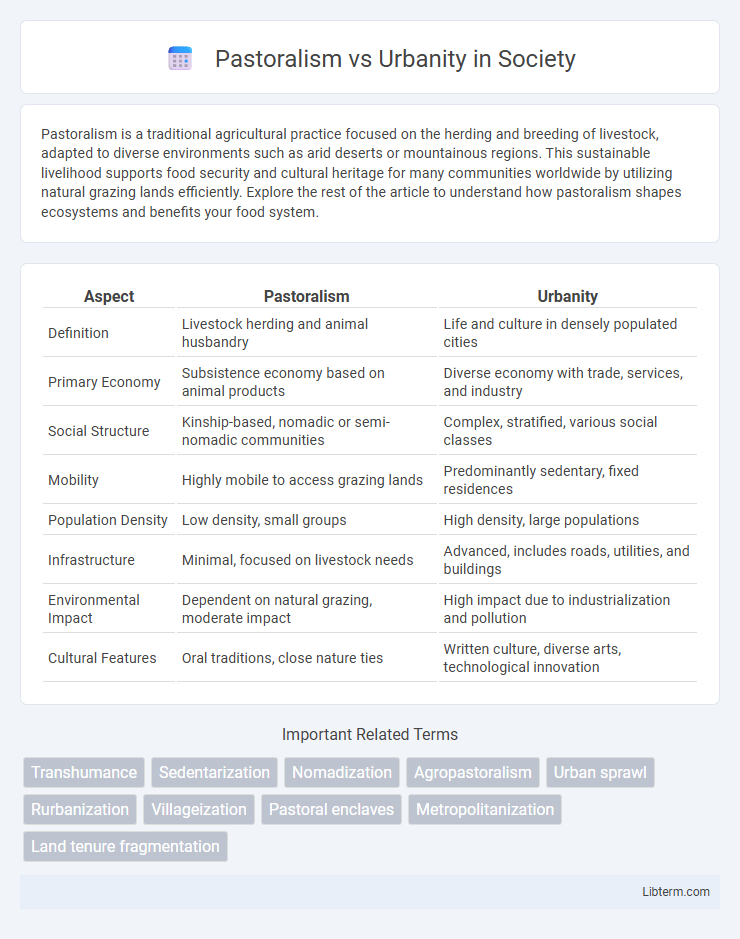Pastoralism is a traditional agricultural practice focused on the herding and breeding of livestock, adapted to diverse environments such as arid deserts or mountainous regions. This sustainable livelihood supports food security and cultural heritage for many communities worldwide by utilizing natural grazing lands efficiently. Explore the rest of the article to understand how pastoralism shapes ecosystems and benefits your food system.
Table of Comparison
| Aspect | Pastoralism | Urbanity |
|---|---|---|
| Definition | Livestock herding and animal husbandry | Life and culture in densely populated cities |
| Primary Economy | Subsistence economy based on animal products | Diverse economy with trade, services, and industry |
| Social Structure | Kinship-based, nomadic or semi-nomadic communities | Complex, stratified, various social classes |
| Mobility | Highly mobile to access grazing lands | Predominantly sedentary, fixed residences |
| Population Density | Low density, small groups | High density, large populations |
| Infrastructure | Minimal, focused on livestock needs | Advanced, includes roads, utilities, and buildings |
| Environmental Impact | Dependent on natural grazing, moderate impact | High impact due to industrialization and pollution |
| Cultural Features | Oral traditions, close nature ties | Written culture, diverse arts, technological innovation |
Defining Pastoralism and Urbanity
Pastoralism is a traditional livelihood system centered on the domestication and herding of livestock, involving seasonal movement to access grazing lands. Urbanity refers to the characteristics, culture, and social organization associated with life in densely populated cities, emphasizing infrastructure, commerce, and diverse social interactions. The contrast between pastoralism and urbanity highlights the shift from rural, animal-based economies to complex, urban-centered societies.
Historical Roots of Pastoralism and Urbanism
Pastoralism, rooted in early Neolithic societies around 10,000 years ago, emerged as humans domesticated animals and adapted to arid and semi-arid ecosystems, fostering mobile herding economies. Urbanism began around 6,000 years ago with the rise of agrarian city-states in Mesopotamia, where centralized governance, trade specialization, and social stratification developed. These contrasting historical trajectories shaped divergent settlement patterns, economic systems, and social structures, influencing the evolution of human civilization.
Sociocultural Values in Pastoral and Urban Societies
Pastoral societies emphasize communal living, reciprocal relationships, and deep spiritual connections to land and livestock, fostering a culture rooted in tradition and collective responsibility. Urban societies prioritize individualism, diverse social roles, and innovation, reflecting a dynamic cultural landscape shaped by economic specialization and cosmopolitan interactions. These contrasting sociocultural values influence social organization, identity formation, and conflict resolution practices within each community type.
Land Use and Environmental Impacts
Pastoralism primarily involves extensive land use with low-intensity grazing, promoting biodiversity and maintaining natural ecosystems, but risks overgrazing and soil degradation when poorly managed. Urbanity features concentrated land use characterized by infrastructure development and impervious surfaces, leading to habitat loss, increased pollution, and altered water cycles. The contrasting land use patterns drive distinct environmental impacts, with pastoralism supporting ecosystem services and urbanity intensifying ecological footprints.
Economic Systems: Livestock vs Industry
Pastoralism centers on livestock rearing as the primary economic activity, relying on animal husbandry for food, trade, and cultural livelihood. Urbanity, by contrast, is characterized by industrial economies that emphasize manufacturing, technological innovation, and service industries for wealth generation. The economic systems in pastoral societies tend to be mobile and subsistence-based, while urban economies focus on fixed infrastructure and market-driven production.
Community Structures and Social Networks
Pastoralism fosters tightly-knit community structures centered on kinship, mutual support, and shared resource management, emphasizing strong social networks based on face-to-face interactions and traditional norms. Urbanity, by contrast, features more diverse and complex social networks shaped by occupational roles, voluntary associations, and institutional affiliations, enabling broader but often less personal community ties. These differing social frameworks influence identity, cooperation, and conflict resolution, reflecting how environmental and economic contexts shape social organization.
Adaptation and Resilience to Change
Pastoralism demonstrates high adaptation and resilience to environmental variability through mobility, diverse livestock management, and flexible social structures, enabling sustained livelihoods in arid and semi-arid regions. Urbanity exhibits resilience by leveraging technological infrastructure, diversified economies, and complex governance systems that facilitate rapid response to economic and environmental changes. Both systems face distinct challenges: pastoralism contends with climate change and land degradation, while urban areas struggle with resource management and socio-economic inequality.
Challenges: Modernization, Migration, and Climate
Pastoralism faces significant challenges due to modernization-driven land privatization and infrastructure development that disrupt traditional grazing routes. Migration to urban areas intensifies pressures on pastoral communities by reducing labor availability and accelerating cultural erosion. Climate change exacerbates resource scarcity through unpredictable rainfall patterns and desertification, threatening the sustainability of pastoral livelihoods.
Policy Implications for Pastoral and Urban Development
Policies addressing pastoralism must prioritize flexible land tenure systems and mobile service delivery to support sustainable livelihoods and prevent conflicts over resources. Urban development strategies require integrating pastoral communities into city planning through inclusive housing, employment opportunities, and social services to reduce marginalization. Coordinated governance frameworks that harmonize rural and urban policies enhance resilience and promote equitable economic growth across pastoral and urban areas.
Future Prospects: Harmonizing Pastoral and Urban Lifestyles
Future prospects for harmonizing pastoralism and urbanity focus on developing sustainable agriculture technologies and smart city planning that integrate livestock management within urban spaces. Innovations like vertical farming, mobile herding apps, and urban grazing zones enhance food security while preserving pastoral traditions. Collaborative policies supporting eco-friendly practices and rural-urban connectivity promote balanced socioeconomic growth and cultural exchange.
Pastoralism Infographic

 libterm.com
libterm.com